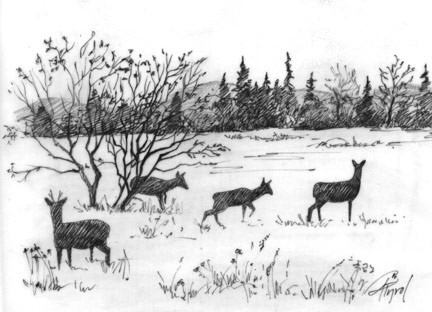
Chronic wasting disease (CWD) has recently been discovered in the Northeast for the first time. CWD is a form of transmissible spongiform encephalopathy (brain disease) that is similar to mad cow disease in cattle and scrapie in sheep. CWD affects members of the family Cervidae, which includes mule deer, white-tailed deer, elk, and moose. While it can cross freely between these species, it has never been found to affect humans or domesticated livestock because of a natural species barrier. Still, in areas where the disease is established, many people are afraid to consume venison.
In infected animals, CWD starts with a single abnormal protein called a prion, which causes lesions or holes in the animal’s brain, making the cerebellum and cortex resemble a sponge. The lesions cause tremors, chronic weight loss, and confused behavior, such as walking in circles or stumbling. Once an animal begins showing these symptoms, which, because of its long dormancy period, may be several years after it is infected, death is at most a few months away.
This “mystery disease” was first documented in captive mule deer in Colorado in 1967. It was named chronic wasting disease when it emerged in Colorado’s wild elk population in 1980, and it quickly spread to the other Rocky Mountain states and Saskatchewan, then into the Plains states and, finally, as far east as Wisconsin and Illinois.
The steady march continues to perplex scientists attempting to pinpoint CWD’s method of transmission. It is currently thought that the prions are shed in feces and passed to other deer that come into contact with those feces, in a process similar to the distribution of some intestinal parasites. A recent paper in the journal Science also suggests that prions can be transmitted through urine. The prion is very hardy and can remain in the field for an indefinite amount of time. Some scientists, however, believe that direct animal-to-animal contact is needed.
Until March 31, 2005, the closest to the Northeast the disease was thought to exist was Wisconsin. Then, 900 miles to the east, CWD was found in a captive white-tailed deer on a small game farm in Westmoreland, New York, followed by a second case from another farm in the same town.
An immediate flurry of media attention, emergency legislation, public forums, and environmental action plans followed the discovery of the infected deer in New York. Although it seemed to many people that the disease had “jumped” from Wisconsin to New York, officials say the disease most likely came from a deer imported from an infected area. Three more deer were confirmed to be infected when the rest of the first herd of 18 animals was killed and tested.
Hopes were high that the disease had not made it into the wild deer population until, on April 27, a wild deer tested positive in the town of Verona, about 8 miles from the Westmoreland farms. Since then, only one more wild case has been found, also in Verona, out of nearly 400 animals tested. Stephen Litwhiler, New York Department of Conservation’s Citizen Participation Specialist, sounds optimistic when he says that CWD in the state may have been caught in the early stages and that with any luck the small number of positive tests “indicates a low incidence in the wild herd.”
This hunting season in New York, emergency regulations in the CWD area require all hunters to bring intact deer carcasses to a check station where they will be registered and tested for the disease. Removing high-risk parts of the animal from the quarantine area, including the brain, eyes, spinal cord, and internal organs, is prohibited, meaning hunters will have to process their meat before bringing it home if they are leaving the containment area borders. Butchering deer killed by vehicles in the containment area is also banned, and there are increased restrictions on taxidermists and wildlife rehabilitators and a ban on feeding wild deer.
Concentration of animals leads to easier transmission of CWD within a herd. Game farms were the original source of the disease, and animals that escape can spread CWD to wild populations. When people feed wild deer, they create a highly concentrated population like that in a game farm. For this reason, as of this year, Vermont made it illegal to feed or bait wild deer.
Though CWD has not been identified in any deer in Vermont or New Hampshire, preparations are underway to counter the possible spread of CWD in both states. In addition to mandatory registration and monitoring of captive deer and elk herds and strict fencing requirements, these states are setting up CWD task forces and encouraging volunteer testing of hunted animals. For the latest information as hunting season unfolds, visit www.vermontagriculture.com/CWD/IndexCWD.htm or www.wildlife.state.nh.us/Wildlife/CWD_QandA.htm.

